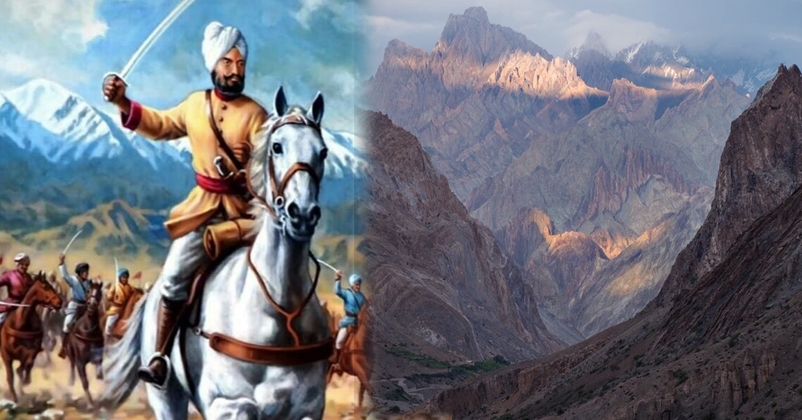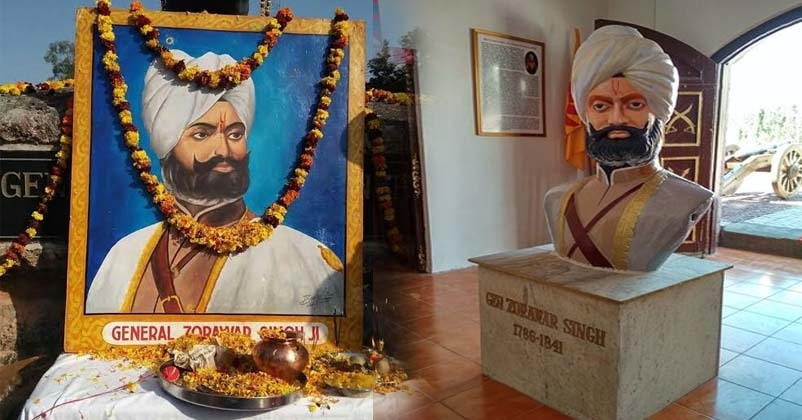Gen. Zorawar Singh of the Dogra Army- A Sikh warrior who adorned the map of India with the “crown” of J&K
| 12-Dec-2020 |

As far as the geographical dimensions of Jammu Kashmir go, the region we can see lies at the junction of Northern Afghanistan and China and its significance can be traced to the international developments that happened in the early 19th century when the British were tightening their grip over India. If we look closely, during that period the Chinese and Russian powers were just next door which also meant that the British-Indian empire had more interest in acquiring the tri-junction. And as we go down in history, we can understand how the present boundaries of today’s Jammu Kashmir and Ladakh UTs were formed. It was when this region was under the reign of Raja Gulab Singh whose kingdom that stretched across 1.35 lakh sq. kilometers ranged from Punjab to Sinkiang and Tibet. It was thus significant for the British to have a stronghold of the region. Further, into Raja’s kingdom, he had warriors like Zoravar Singh – who helped him conquer the Principalities of Bhimber, Rajouri, Bhadarwah, and Kishtwar, extending from Rawalpindi to Ladakh.
General Zorawar Singh Kalhuria was born to a Rajput family of Kulhar, (present-day Bilaspur in Himachal Pradesh) in 1786. Although truly little is known about his early life, it is learned that young Zorawar had left his home at the age of 16. He took up a job as a private servant of Rana Jaswant Singh, the Jagirdar of present-day Ramnagar. And soon after, a young Zorawar Singh found himself in the great king’s army when Raja Gulab Singh decided to extend his kingdom to Ladakh and Baltistan in 1834 and he gave this job to Wazir Zorawar Singh who successfully led six expeditions into Ladakh between 1834 and 1841.
Zorawar Singh initially conquered Kishwar from its Nawab and by the manner Kishwar was acquired, it encouraged him to conquer Ladakh in 1834. He led his Dogra warriors into the remote and that was how previously thought inaccessible region of Ladakh where he defeated the Botis, resulted in the capture of Kargil. This led the Ladakhis to gather a huge reinforcement from the Chinese, however, despite limited supplies, the enemies of Zoravar Singh faced a decisive defeat under the leadership of the Dogra General Gyalpo. Later in 1836, the Ladakhis along with Sikh Governor, Mehen Singh clashed again with Dogras against Zoravar Singh, but faced a devastating defeat by his hands thus adding the vast Ladakhi regions to India.

In the year following, Zorawar Singh entered Baltistan, which was then under an Afghan commander. It had been with the Afghans since the days of Ahmed Shah Abdali. He took advantage of an internal squabble among the rulers to extend the Sikh empire into the cold and mountainous region. Skardu, the capital, was attacked by an army of Dogra soldiers and newly recruited Ladakhi militiamen. The incumbent king, Ahmed Shah was deposed and put in prison. In 1841, as Shah lost the region to Dogra warriors, Baltistan also agreed to the suzerainty of Jammu and Gulab Singh. After which Zorawar pledged to capture the alien territory of Tibet the further east.
Meanwhile, by annexing Baltistan and earlier Leh and Ladakh, Zorawar Singh gave Jammu and Kashmir much of the shape it still retains today. Although Baltistan is, unfortunately, a part of Pakistan occupied Jammu Kashmir currently.
The Conquest of Tibet and a "Pledge"
Since the remaining part of Kashmir valley was not under Gulab Singh at that time, the route followed towards Tibet by Zorawar Singh was through Kishtwar, Padar and Zanskar. And so, in May 1841 with a force of about five thousand men General Zoravar left for Tibet with a pledge not to return until winning Lhasa.
In the Tibetan territory, while facing fierce engagements with Chinese troops and after successfully refuting them, the Dogra warriors with Zorawar Singh reached Minsar that was near the holy lake of Manasarovar and Kailash Mountain. There, Zorawar built a fort near Taklakot, a village near Nepal and North West Province (currently Uttarakhand), and stayed there due to extreme cold weather. By this time, however, the Chinese sent a large reinforcement towards him. On learning this, Zoravar Singh instead of defending the advancing army chose to attack, which unfortunately did not turn in his favor and after battling on 11th and 12th December 1841, he succumbed to injuries in the battle of To-Yu.
Why General Zorawar Singh is considered the “Little Napoleon of India”
In the Battle of To-Yu, when the Sikh warrior fought close to Toklakam, Zorawar Singh found his supply lines stretched thin. He had lost many men. However, Singh fought courageously with a few soldiers by his side who died more by the blistering cold than due to the war at the height of sixteen thousand feet above sea level. Zorawar Singh’s demise was a grave blow to Gulab Singh's prestige and taking advantage of the same, the Tibetan army retaliated. However, a huge force under Dewan Hari Chand from Jammu suppressed the rebellion of the Tibetan forces who faced a crushing defeat that avenged the defeat of To-Yu. Later, the Tibetan Government approached for a peace treaty, that was signed in September 1842 (on the 2nd of Asuj, 1389 Vikrami) between Diwan Hari Chand and Wazir Ratnu on behalf of Gulab Singh and Kalon Surkhan with Depon Pishy on behalf of Dalai Lama.
By this treaty, the traditional boundary between Ladakh and Tibet was accepted as boundary between Jammu and Tibet as 'recognized by both sides since olden times.'